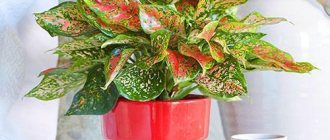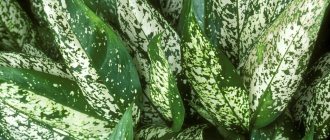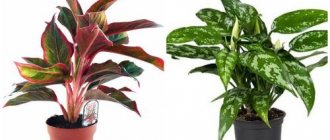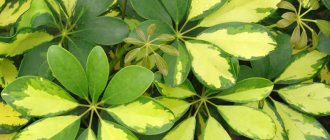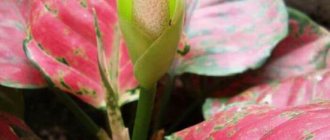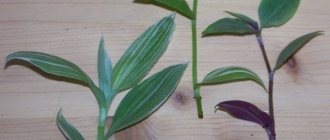Indoor plants not only serve as interior decoration, but also create a special atmosphere in the house. Many people believe that flowers grow and develop well only in an apartment with a good energy background. In fact, they require proper care and aglaonema is no exception.
In order for the plant to develop and please its owner, it is necessary to comply with growing standards. This article describes 12 basic rules that will help beginners grow a beautiful and healthy “beauty”. I tried my best for you, from my own experience, so save the page on social networks.
Transfer
Purchased specimens are replanted only after 1–2 weeks. During this period, the bush will adapt to the microclimate of the apartment, and at the same time it will pass quarantine. Transport soil is not the best environment for a seedling, but it is better to wait the allotted time and take your time.
Subsequently, aglaonema is replanted annually up to 3-4 years, older bushes once every 4-5 years.
How to understand that a flower needs a transplant:
- no annual growth;
- roots protrude above the soil surface and into drainage holes;
- water after watering does not go deep into the pot for a long time;
- the flower has a sickly, pale appearance;
- More than 4 years have passed since the transplant.
Note! The juice and berries of the plant are poisonous. When working with flowers, you must use gloves and wash your hands thoroughly.
Step by step transplant process:
- The bush is watered the day before transplanting. If a complete replacement of the soil is required, there is no need to water.
- A 2–4 cm drainage layer and a little nutritious soil mixture are poured into the new pot.
- Remove the flower from the old pot, trying not to break the earthen lump. If replacement is needed, the old soil is carefully shaken out from the roots.
- Next, install it in the center and little by little fill it with new soil.
- The pot is shaken periodically so that the soil fills all the voids.
- If support is needed, it is placed before filling the soil.
- The depth of the barrel is left at the same level.
The flower is watered and placed in partial shade for adaptation. After a week, the bush is returned to its usual place.
Choosing a pot and preparing the soil
A stable, wide, but not too deep pot with drainage holes and a tray is suitable for planting. Flower growers advise using containers made of plastic or coated ceramic. The diameter of the new pot should exceed the old one by only 2–3 cm.
A pot that is too large will result in the aglaonema taking a long time to grow roots, and the green mass will stop developing.
Aglaonema is undemanding to the composition of the soil, but the soil must be loose and nutritious. For planting, a purchased soil mixture for decorative foliage and bulbous plants is suitable. You can mix the soil yourself, observing the proportions.
Soil composition:
- 3 parts leaf soil;
- 1 hour humus;
- 2 parts of river sand, poured or vermiculite;
- 2 hours peat;
- charcoal.
A drainage layer of expanded clay, broken brick, polystyrene foam or small gravel must be added to the pot.
How often to water aglaonema?
Aglaonema does not like flooding.
In the case of aglaonema, a simple rule applies: it is better to underfill than to overfill .
In warm, well-lit places, water when the soil in the pot dries 5-7 cm. To check, you can use special soil moisture meters, but the good old method - testing the soil by touch with your finger - works great.
If your plant is in a darker, cooler area, allow the soil ball to dry out completely between waterings.
If you are late with watering, the leaves of the aglaonema will wilt a little, this is a signal that it is definitely time to water. After watering, they quickly restore their decorative properties.
Important! If the stem has become soft, most often this is a sign of flooding rather than drying out of the plant.
Why is it better to underfill? The stems of Aglaonema are succulent and contain a large amount of moisture - this is how the plant naturally prepares for dry periods without rain. When aglaonema’s “legs” are constantly in water, and water, due to the characteristics of the plant, is constantly present in significant quantities in the stems, the flower becomes easy prey for rot. Rot develops quickly and can affect all parts of the plant.
Unregulated watering is the most common cause of problems with aglaonema.
A pot with wick watering will help you avoid it almost completely. Aglaonema will happily regulate the amount of water it needs for successful growth. All you have to do is check the water level and add it from time to time. Such a pot, by the way, also solves the question of “how to leave a plant during a vacation or business trip.” Among the budget options for wick pots, you can use the Grace flower pots - they are available in the Leroy Merlin assortment, you can also order similar options online.
You can read about the problems characteristic of aglaonema in a separate article.
Lighting, choice of location
In its natural environment, aglaonema grows in the shade of large plants, so it is better to place the pot in partial shade in the house. The flower is light-loving, but direct rays are destructive to delicate leaves and can leave burns on them.
Note! Purchased specimens cannot be immediately placed on the windowsill. They need adaptation to natural light within 1–2 weeks.
The ideal place for the pot would be an eastern or western window sill. On the south window you will have to shade it with tulle, larger plants or place it at a short distance from the light source.
Variegated varieties turn pale from lack of light and lose color, becoming monochromatic.
Popular beliefs
In Malaysia and India - the homeland of aglaonema - the plant is considered a flower of good luck . This belief comes from the following story. One person had aglaonema growing in his garden. One day a man saw drops of dew on its leaves, which were laid out in the form of numbers, and bought a lottery ticket with such a combination. The ticket won and the story of aglaonema, which brings good luck, spread throughout the world.
Of course, aglaonema will bring good luck to your home, and will also attract prosperity to the owner’s house: the plant purifies the air in the room where it is located.
Why does it bloom?
Aglaonema is very sensitive, and its leaves will turn yellow not only if placed in the wrong place, but also if it grows in a house with a heavy atmosphere.
Aglaonema will wither, turn yellow and stop growing and blooming in a house whose owners often quarrel and create scandals. And, on the contrary, if aglaonema blooms, this means that happy times await your family hearth .
What do they say about the Maria variety?
Aglaonema variety Maria has calm green leaves. This type of aglaonema is purchased by dysfunctional families, as it brings peace to the house and makes the environment comfortable.
What will other species bring to their owners?
Round
A very beautiful flower. It has become a favorite indoor plant due to the unusual color of the leaves and the pink stripes on them. If you place a plant in the bedroom, the feeling of love in the couple will strengthen, the flame will reappear in the relationship, and the partners will become more relaxed.
Crete
It differs from other species in its rich red or pink color; The plant is best suited for lovers who want to strengthen their relationship.
With an unusual color
Leaves that have a white stripe or light green spots will help bring good luck to your side and improve your financial condition.
Watering schedule, air humidity
Aglaonema is sensitive to the composition of water. To water it, it is better to use warm, filtered, bottled or settled water. Increased rigidity will lead to loss of decorativeness.
During the growing season, the flower is watered only when the top layer of soil has dried out 3–4 cm deep. But it is worth considering that flooding is just as harmful as drought and monitoring the condition of the earthen clod and roots. At this time, the leaves are sprayed daily, and expanded clay, pebbles or moss are poured into the tray, which are regularly moistened.
During dormancy, watering is reduced to once a week, but only if the plant is kept in a room with a temperature no higher than +16 °C. If the flower does not “fall asleep,” then the watering schedule remains the same.
Types of Aglaonema domestica
There are about 50 species of aglaonema known to grow in nature. Some of them are grown at home. Depending on the height of the plant, species are divided into 3 groups.
Low growing aglaonemas
Height up to 0.25 m; leaves are creeping or drooping. The most popular 3 varieties:
Aglaonema rotundum
Dark green, heart-shaped leaves with bright pink stripes running along the veins along the entire length of the leaf. The flower is a pink spadix surrounded by a pink and white blanket.
Aglaonema costatum
The trunk branches at the base. Oval green leaves with light spots and stripes. Leaf length is up to 20 cm, width is half that. The flower is a white spadix covered with a green blanket. The smallest aglaonema.
Aglaonema Brevispathum
The trunk is located underground. Narrow green leaves of an elongated shape. There is a vertical white stripe in the center. Produces few leaves. The flower is a spadix covered with a white blanket.
Medium-sized varieties
Bushes up to 50 cm high. The trunk is straight. The leaves are long – up to 30 cm.
Aglaonema Maria
Bush up to 60 cm high. The length of green leaves covered with white spots is 20 cm. The white cob is wrapped in a white blanket. It can grow under artificial light without losing its decorative effect.
Silver Queen
Silvery blue leaves with green streaks. Leaf length – from 15 – 30 cm. Bush height – up to 0.4 m. The white cob is covered with a white blanket only on one side. Loves a lot of light.
Aglaonema Treubii
Green leaves with a silver pattern reach 17 cm. The white cob is wrapped in a snow-white blanket. The most unpretentious type of domestic aglaonema.
Tall aglaonemas
Popular varieties obtained from shade-tolerant species.
Aglaonema Silver Bay
The bush branches from the roots. The trunk is slowly exposed. The height of an adult bush can reach 100 cm. Pointed leaves are up to 30 cm long. In the center they are pale green, along the edges there are dark stripes and spots. The underside is dark green. In an adult bush, the leaves darken. Resistant to cold.
Aglaonema pictum Freedman (Gabriel, Cecilia)
Large, wide leaves with wavy curves along the edges. In the center of the leaf there are light spots, along the edges and closer to the center there are dark green specks. Bush height – up to 150 cm.
Aglaonema Stripes (Aglaonema Stripes)
Oval wide leaves with pointed ends grow up to 35 cm. Dark green stripes alternate with light ones. Connecting at the tip, they form a small light spot.
An exotic ornamental plant, the beauty of which lies not in the original bright flowers characteristic of exotics, but in its unusual leaves. The color of the foliage surprises with the play of green shades with light stripes and spots. Bizarrely located on the leaf plate, they create a special variegated pattern that distinguishes it from other plants. A guest from the tropical forest is a worthy decoration of a modern interior.
Fertilizers and fertilizers
It needs to be fed only during the growing season, which lasts from March to August. Any complex composition containing nitrogen and potassium is suitable.
I recommend watching the video (be sure to watch it to the end), you will learn a lot of new things:
Note! Store-bought fertilizers often contain harmful components, so some gardeners prefer to use their own recipes .
Feeding:
- Mineral water (slightly carbonated, non-carbonated) will help nourish the flower with beneficial microelements. You can water it with soda once a week.
- Unsalted vegetable broth from any root vegetables. Can be used 2 times a week, actually replacing regular watering.
Complex mineral supplements:
- ETISSO fertilizer for indoor plants in the form of sticks. The complex contains nitrogen, phosphorus, potassium, magnesium, iron, copper, zinc. The stick is stuck into the soil and during watering it slowly dissolves and saturates the soil with useful substances. One stick is enough for a month.
- BONA FORTE is a liquid, concentrated fertilizer for decorative foliage plants. Contains phosphorus, potassium, magnesium, succinic acid, nitrogen, zinc, copper and other trace elements. For root feeding, dilute 10 ml/1.5 liters of water at the rate of 0.5 liters per bush. For spraying 5 ml/1.5 liters. The interval between procedures is 14 days.
Anti-aging pruning
As the trunk grows, it gradually becomes bare and the aglaonema loses its decorative effect. Therefore, flower growers recommend anti-aging pruning. Typically, the procedure is required for specimens older than five years.
The upper part is cut off so that all the leaves and part of the bare stem remain on it. The cut areas are dried a little, and then sprinkled with charcoal or covered with paraffin.
The hemp in the pot is covered with a bag and put in a warm, bright place until the buds appear. The bag is regularly removed and condensation is removed.
The top is rooted in soil mixture or water with stimulants. Thus, it will be possible not only to renew the old bush, but also to grow a new aglaonema.
Actually, this is how the flower reproduces. Therefore, this section will not be included, since it is simple and even a beginner can handle it. You just have to want it and you will succeed.
Reproduction of aglaonema
If the flower trunk begins to branch or become bare, the plant is ready to reproduce. Reproduction is possible in different ways.
Reproduction by dividing the bush
The easiest method.
- Take the aglaonema out of the pot and inspect the root system.
- Fragments with a developed root system are separated.
- They are planted in separate containers.
- Water, cover with film and leave at a temperature of + 23°C for several days for the plant to take root.
- It is periodically watered and sprayed.
Propagation of aglaonema by cuttings
Conducted when the trunk is exposed.
- The apical shoot up to 10 cm long is cut off, the cut is sprinkled with coal powder and dried.
- Then they are immersed 5 cm in wet sand.
- Cover with film and keep for a month at + 25°C until the bush gives roots.
- Water and ventilate periodically.
Growing aglaonema from seeds
Perhaps when the aglaonema self-pollinates. The plant produces scarlet fruits. When they ripen on the bush, the seeds must be removed from the berries, washed and planted in a mixture of peat and sand, taken in equal parts. Pour, cover with film and leave at + 25°C. The first shoots appear quickly. When 2–3 leaves appear, the bushes are planted in separate pots. After 3 years you will get strong plants.
All propagation methods are accessible and simple, but it is important to know that when propagated by seeds, aglaonema loses its varietal characteristics.
Formation of a spreading crown
Some new gardeners complain that their “favorite” does not branch or grow. There may be several reasons, but there are tricks that will help make the crown more luxuriant.
Recommendations:
- the pot should be tight and exceed the volume of the earthen ball by only 2–3 cm;
- pinching the upper buds stimulates the growth of lateral shoots;
- overgrown, but not very branched shoots are cut at a distance of 6–7 cm from the ground, rooted and planted next to the mother bush.
Flowering period
In the natural environment, the flowering period occurs in July or August. In apartment conditions, the bush gains color from June to September. But aglaonema is more often valued for its decorative leafy qualities. Therefore, experts advise trimming the flower stalks. Especially on young bushes.
In the process of forming buds, it spends a lot of energy, sheds its leaves, slows down its growth and may die. To prevent this from happening, the plants must be fed, the temperature maintained at the same level, and a watering and spraying schedule maintained.
Briefly about the plant
The permanently green plant has erect, short, fleshy branches, but there are aglaonemas with trunks branching at the base.
Young plants have almost no stem, but in older ones you can see a short stem with traces of fallen leaves. The shrub has dense, leathery, broadly ovate leaves. The color of the foliage depends on the species and variety.
The inflorescence of the flower itself is a spadix of greenish color and with a white tint. The cob can be thin, cylindrical, or thick, club-shaped. Over the course of six months, bright orange or ruby fruits are formed, having an elongated shape with seeds inside.
Rest period
The dormant period of Aglaonema is weak; if the temperature in winter remains within +18-+23 °C, the plant will not “fall asleep”. In this case, there is no need to reduce watering and lighting. But it is better to postpone fertilizing until spring.
The winter dormancy period begins around October. It is necessary to gradually reduce the temperature to +14 °C, reduce watering to once a week, but at the same time regularly spray the bushes with warm water. In this condition, the pot can stand until the end of February.
It is necessary to monitor the condition of the flower and prevent the soil from drying out. If the plant begins to wither and wither, then you need to “awaken” it ahead of schedule.
Diseases and pests
Unfortunately, not a single flower is immune from pests. But in order to save him, it is necessary to act immediately and not postpone treatment until later. At an early stage, pests do not have time to cause significant damage, so aglaonema can and should be saved.
The scale insect can be seen without a magnifying glass. Pests look like brown bumps that cannot be removed with a fingernail. They are usually found on the inside of a leaf or stem.
| Drug name | Instructions |
| Aktellik | 1 ampoule per liter of water. Leaves are treated with the solution at the rate of 2 l/10 m². The treatment is repeated four times with an interval of 4 days. |
| Aktara | 8 g of powder per 10 liters of water, spray the resulting solution onto the leaves and stems. Repeated treatment after 4 days. |
The mealybug is localized on stems and leaves. Pest colonies resemble pieces of cotton wool or mold.
| Product name | Instructions |
| Fufanon-Nova | 2 ml/0.5 l water. Plants are treated with the solution at the rate of 1.5 l/10 m². |
| Doctor "Green Gardener's Pharmacy" | The finished briquette (arrow) is stuck into the ground at a distance of 2–4 cm from the plant stem. For a pot with a diameter of 10 cm - 2 arrows, 12–15 cm - 3 arrows. The protection lasts about 90 days. |
Aphids are small greenish insects with transparent wings.
| Drug name | Instructions |
| Fitoferm | 4 ml/500 ml water. Requires four-time treatment with breaks of 7 to 10 days. Consumption 1l/10 m². |
| Biotlin, VRK | 5 ml/10 l water. Repeated treatment after 6 days. Solution consumption 1 l/10 m². |
Spider mite
| Product name | Instructions |
| Kleschevit | 2 ml per liter of water. Three times with an interval of 10 days. |
| Augustine | 1 ml / 2.5 l of water. Four times treatment with an interval of 8-10 days. |
What place in the house to choose for aglaonema
What place to choose at home for Aglaonema
Aglaonema will decorate any living space. It remains decorative all year round, its flowers are odorless, and its leaves purify the air from benzene, formaldehyde, trichlorethylene, carbon monoxide, which enter the air of our apartments from furniture, wallpaper, floor coverings, household chemicals, etc. Aglaonema is on the list of plants that purify the air best, so it is ideal for both the bedroom and living room. In addition, aglaonema has a lot of colors and varieties - you can choose a plant to suit your taste.
The only point worth considering is that aglaonema juice is poisonous and can cause irritation and an allergic reaction in humans and animals if it comes into contact with mucous membranes. So place the plant out of reach of playful hands and paws.
Another competitive advantage of aglasha in the indoor plant market: it can grow successfully under fluorescent lamps . This makes it an excellent choice for the office: minimum maintenance, minimum watering, maximum beauty.
Important: aglaonema does not like drafts - neither cold (from an air conditioner, a window open in winter), nor warm (from a heater). It can react to drafts by drying out the leaves. Temperature changes of more than 10 degrees in a short period of time can be destructive for aglaonema. The optimal temperature for aglaonema is +22-+30. Try to arrange your plant so that it does not get exposed to wind.
Errors
Aglaonema is a fairly resilient plant that rarely gets sick (it’s not for nothing that it’s Leon’s favorite from the movie of the same name). In most cases, problems with flowers occur due to mistakes by flower growers, as well as non-compliance with care rules.
| Symptoms (signs) | Causes | Recommendations |
| Rotting of the stem and roots | Stagnation of moisture at the roots due to excessive watering and lack of drainage holes in the bottom of the pot. And also due to freezing of the root | If not only part of the stem is affected, but also the roots, then the plant cannot be saved. The tops of the bush are cut off “alive”. The roots are thrown away along with the soil, and the cuttings are rooted |
| Leaves are rich in color, lose their variegation of color, turn pale | Lack of nutrients, lack of lighting | Adjust the feeding schedule during the growing season and move the pot to a lighted windowsill. In winter, you can install a special lamp |
| The tips of the leaf blades darken and dry out | Lack of humidity | The plant is removed away from heating devices and sprayed daily with a spray bottle. An automatic humidifier, a glass of water on the windowsill, or wet moss in a tray can increase humidity. |
| Leaf blades curl and turn black | Low temperature, high humidity, cold draft | The pot is transferred to a warm room where there is no draft |
| Pale yellow spots appear on the leaf blades | Sunburn | The flower is removed from the sun and placed in diffuse partial shade |
| There are small dark spots with a vague outline on the leaves | Watering with hard or cold water | The flower is transferred to watering with settled, filtered or bottled water. As a preventive measure, water with an aqueous solution of citric acid at the rate of 0.2 g/10 l for a week. |
| The lower leaves turn yellow and fall off | This is a natural process, but only if the phenomenon does not become widespread | Care does not change. If the plant has lost its decorative appearance due to a bare trunk, rejuvenating pruning is carried out |
| The edges of the leaves dry out, the plate becomes deformed | Insufficient watering | Reduce the interval between waterings |
| New leaves are small, faded and weakened | Lack of nutrition, possibly cramped potty | If necessary, the flower is replanted and complex fertilizer is applied. |
| Transparent drops form at the tip of the leaf blades | High air humidity or excessive watering | The plant gets rid of excess moisture, so it is necessary to review the watering schedule and measure the humidity |
| Slow development, complete cessation of growth | Lack of nutrients, cramped pot, low temperature, poor lighting and watering | This is a slow-growing plant, therefore, if there are no obvious violations, adjustment is not required |
Caring for aglaonema at home. Details
The aglaonema flower develops correctly in indoor conditions and feels good if its needs for light, warmth, nutrition and moisture are met.
Landing
The high decorative properties of the plant largely depend on proper planting.
The quality of planting material (cuttings, seeds, fragment of a bush) is important. If you choose the seed planting option, use only fresh seeds collected from ripe scarlet berries. Planting is carried out in spring and summer. A fertile, loose, breathable acidic substrate will provide the plant with good nutrition and improve its appearance. Planting aglaonema involves choosing the right place. The flower feels comfortable on a window facing any side except the south: bright sunlight can cause burns to the foliage.
Bloom
Aglaonema rarely blooms at home.
The beauty of the plant lies in its variegated emerald leaves. Aglaonema flowering is an unattractive phenomenon. From February to November, inconspicuous inflorescences in the form of greenish-yellow cobs, wrapped in a pale blanket, form in the axils of the upper leaves. There can be 1 - 3 pieces. Depending on the variety, the cobs look like a thick short club or a thin long cylinder. Sometimes gardeners sacrifice inflorescences and cut them off for the sake of new leaves. If you don’t do this, you can wait for the fruits to appear - scarlet (less often white) berries with a single grain inside.
Temperature
To preserve the decorative appearance of the flower, it is important to strictly observe the temperature regime. Aglaonema is a heat-loving plant. Drafts and sudden changes in temperature can destroy it. Although there are varieties that can withstand cold temperatures down to + 10°C, the optimal temperature for a flower is considered to be between 15 – 25°C in summer and 15 – 18°C in winter.
If you do not water in winter, the plant can tolerate lower temperatures.
Spraying
The tropics are characterized by high air humidity. To make indoor aglaonema feel comfortable, you need to spray the plant twice every 14 days in the summer, take a warm shower, or wipe the leaves with a damp cloth more often. Just don’t allow moisture to accumulate in the rosette of leaves: this can lead to the death of the plant.
In winter, spraying is carried out less frequently, but the flower is placed in a tray with moistened expanded clay or pebbles . During the heating season, the flower is kept away from radiators, air humidifiers are used, or an open container of water is placed nearby.
Lighting
Lighting is important for plant growth. Aglaonema is genetically configured to receive a lot of light, but it should not be bright and scorching, but diffused.
The scorching summer sun can burn the flower, so windows facing south are dangerous for it. It is best to place green-leaved bushes in partial shade. Variegated types of aglaonema, on the contrary, love bright sunlight: under its influence the leaves become more beautiful. But a little shading is also beneficial for these species. In winter, additional lighting is installed for them.
Watering
The plant is moisture-loving, but stagnation of water is detrimental to it. Watering of aglaonema is carried out in spring and summer, when the top layer of soil dries out.
In winter and when aglaonema is kept in a cool room, this is done less often - about once every 10 days. For irrigation, take clean water, settled in the room.
Pot size
There are no small details in the maintenance of the plant. For proper development, even the size of the pot in which the flower is planted is important. A low pot of small volume is preferable. The tightness will stimulate the formation of new leaves and strengthen the root system of the bush.
Priming
Breathable, moisture-retaining soil for aglaonema is very important. The flower grows well in acidic, loose soil. These characteristics correspond to the ready-made soil mixture for bulbous plants. You can make the soil yourself by taking garden soil, peat, perlite (1: 2: 1), and put 2 times more leafy soil for young bushes.
You can add charcoal to the mixture. For mature plants, the amount of turf soil can be increased.
Feeding and fertilizer
Feeding and fertilizing with mineral and organic substances is an important component of flower care.
Aglaonema is fertilized once every 2 weeks with liquid formulations for decorative foliage plants, containing not only the main elements, potassium, phosphorus and nitrogen, but also microelements that prevent alkalization of the soil. To preserve the decorative appearance of the foliage, foliar feeding is carried out: the leaves are sprayed with diluted liquid fertilizer. It is best to do this after watering in cloudy weather, so as not to accidentally burn the plant. All feeding is carried out from the beginning of March to the beginning of October.
You cannot fertilize in winter, because the plant is resting at this time.
Transfer
Aglaonema is transplanted for the first time a week after purchase. When it adapts a little to home conditions, it is transferred from a temporary pot to a permanent container. Young bushes are replanted once a year, adults - once every 4 years. Replanting aglaonema is necessary when the roots completely entwine the earthen ball. It is always produced in the spring.
A new pot is chosen 20 - 30 mm larger than the previous one. It must have drainage holes and a place to pour a thick layer of drainage, which is necessary so that the water in the pot does not stagnate. The soil is carefully selected, taking into account that it loves acidic and loose soil. The soil mixture should include turf soil (an adult bush can put more of it), peat, leaf soil, charcoal and perlite (sand).
Rest period
Like most plants, the dormant period of aglaonema falls in winter . At this time, they reduce the amount of watering and stop stimulating growth with fertilizers and fertilizing.
Trimming
When aglaonema grows, its trunk becomes exposed. This suggests that the flower needs pruning , with the help of which its rejuvenation is carried out. Cut off the top of the plant with a sharp knife, and dust the cut areas with charcoal powder. The stump is left in the pot.
They continue to take care of it and wait for renewal buds to appear. And the top is rooted in water in which activated carbon is pre-dissolved to avoid souring. Sometimes the top is immediately planted in moist soil. Cover with polyethylene and keep at a temperature of +25°C until rooting.
Homemade aglaonema does not require special care; if properly maintained, it will grow healthy and become a real decoration of the interior.

